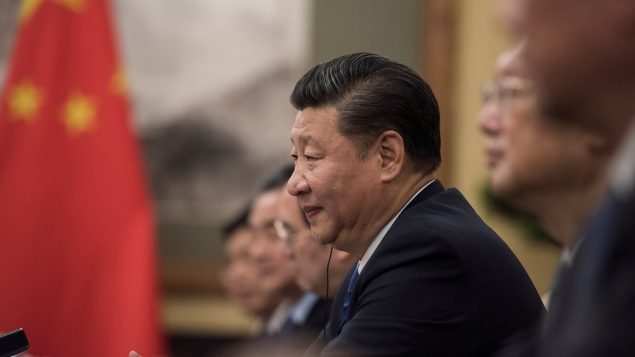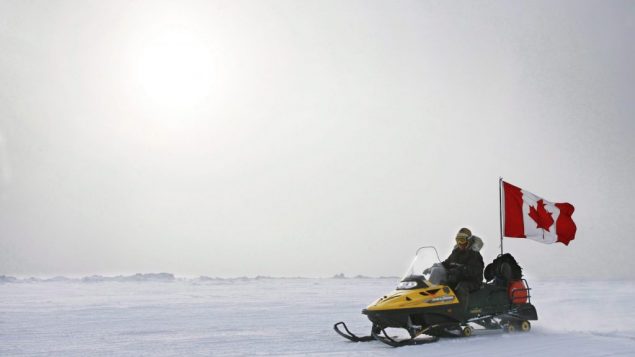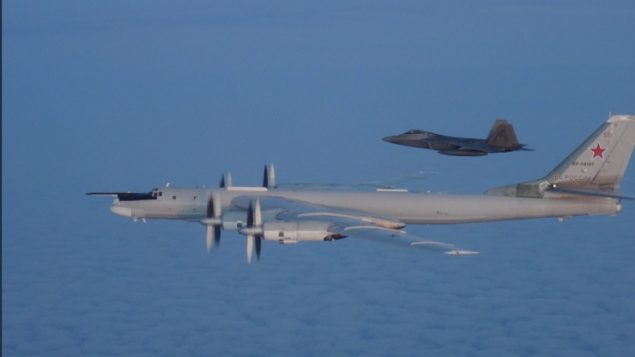The U.S. Air Force released this week its strategy for defending the United States and Canada from threats posed by Russia but also China and other adversaries as beefing up continental defences increasingly takes the centre stage in relations between Ottawa and Washington.
The strategy covers two separate but highly interlinked commands: the North American Aerospace Defence Command (NORAD), a binational U.S.-Canada command, and United States Northern Command (USNORTHCOM).
NORAD is responsible for three missions in defence of the U.S. and Canada: aerospace warning, aerospace control, and maritime warning.
USNORTHCOM is the U.S. geographic combatant command responsible for defence of the U.S. territory. U.S. Air Force Gen. Glen VanHerck commands both USNORTHCOM and NORAD. Royal Canadian Air Force Lt.-Gen. Alain Pelletier is NORAD’s deputy commander.
“Over the last three decades, our nations’ competitors and potential adversaries have watched Canada and the United States and our way of deterring, competing, and conducting war,” the strategy reads.
“They have adapted and developed advanced capabilities in all domains challenging us at home and across the competition continuum, and holding at risk our people, our critical infrastructure, and our power projection capabilities.”
The ability by the U.S. and Canada to field a “capable and persistent defence at home” is a prerequisite to deterring future conflict, the strategy says.
“Our ability to deter in competition, de-escalate in crisis, and deny and defeat in conflict requires all-domain awareness, information dominance, and decision superiority,” the strategy reads.
“We must improve critical infrastructure resiliency, strengthen partnerships, and provide rapid
flexible options and decision space in support of civil authorities.”
‘Today’s threat environment is likely the most complex we have ever faced,’ says VanHerck

A Russian Air Force MiG-31 fighter jet flies during the Victory Day parade, marking the 73rd anniversary of the victory over Nazi Germany in World War Two, above Red Square in Moscow, Russia May 9, 2018. (Sergei Karpukhin/REUTERS)
In his testimony to the Senate Armed Services Committee on Tuesday, VanHerck said the geostrategic environment continues to evolve rapidly.
“In the last decade, we’ve seen a sharp resurgence in the nation-state threat as our global competitors deploy increasingly sophisticated capabilities to hold the United States and Canada at risk and limit our options in a crisis,” VanHerck said.
In the meantime, the terrorist threat that the U.S. government had focused on since the 9/11 attacks hasn’t gone away, he added.
“As a result, today’s threat environment is likely the most complex we have ever faced, as potential adversaries threaten us in all domains and from all vectors,” VanHerck said.
Russia presents a persistent, proximate threat to the United States and Canada and remains “the most acute challenge” to the defence of North America, he said.
“Russian leaders seek to erode our influence, assert their regional dominance, and reclaim their status as a global power through a whole-of-government strategy that includes information operations, deception, economic coercion, and the threat of military force,” VanHerck said.
In peacetime, Russian actors conduct sophisticated influence operations to fan flames of discord in the U.S. and undermine faith in its democratic institutions, he added.
“In crisis or conflict, we should expect Russia to employ its broad range of advanced capabilities—non-kinetic, conventional, and nuclear—to threaten our critical infrastructure in an attempt to limit our ability to project forces and to attempt to compel de-escalation,” VanHerck said.
Russia has fielded new offensive capabilities over the last several years, including advanced cyber and counterspace weapons and a new generation of long-range and highly precise land-attack cruise and hypersonic missiles, he said.
Russia continues to conduct frequent military operations in the approaches to North America.
“Last year, NORAD responded to more Russian military flights off the coast of Alaska than we’ve seen in any year since the end of the Cold War,” VanHerck said. “These Russian military operations include multiple flights of heavy bombers, anti-submarine aircraft, and intelligence collection platforms near Alaska.”
The Kremlin in turn accuses the U.S. and its NATO allies of constantly expanding the military alliance closer to Russia’s borders, threatening its vital national security interests. Moscow has slammed Washington’s moves to withdraw from nearly all Cold War-era arms-control and confidence-building treaties, including the 1972 Treaty on the Limitation of Anti-Ballistic Missile Systems (ABM Treaty), the 1987 Intermediate-Range Nuclear Forces (INF) Treaty and the Open Skies Treaty.
Meeting China’s challenge

China’s President Xi Jinping speaks to Canadian Prime Minister Justin Trudeau during a meeting at the Diaoyutai State Guesthouse in Beijing, China Dec. 5, 2017. (Fred Dufour/REUTERS/POOL)
In addition to challenges posed by Russia, China continues to pursue an aggressive geopolitical strategy that seeks to undermine U.S. influence around the globe and shape the international environment to its advantage, VanHerck said.
China has made deliberate attempts to increase its economic and political influence with Mexico and The Bahamas, he added.
“China remains among the world’s most capable and brazen cyber actors, stealing volumes of sensitive data from U.S. government, military, academic, cleared defence contractors, and other commercial networks each year,” VanHerck said.
“In a crisis, China is postured to transition rapidly from cyber exploitation to cyber attack in an attempt to frustrate our ability to flow forces across the Pacific, and globally.”
China also continues to expand and modernize its strategic nuclear forces to rival those of Russia and the U.S., he said.
‘A zone of international competition’

Ranger Joe Amarualik, from Iqaluit, Nunavut, drives his snowmobile on the ice during a Canadian Ranger sovereignty patrol near Eureka, on Ellesmere Island, Nu., on March 31, 2007. (Jeff McIntosh/THE CANADIAN PRESS)
The USNORTHCOM and NORAD strategy identifies the Arctic as “a zone of international competition” with both Russia and China increasing their activity in the region.
“Russia’s fielding of advanced, long-range cruise missiles capable of being launched from Russian territory and flying through the northern approaches and seeking to strike targets in the United States and Canada has emerged as the dominant military threat in the Arctic,” the strategy reads.
“We will defend the United States and Canada in and through the Arctic, with allies and partners, including Indigenous peoples and governments, by building Arctic awareness, enhancing Arctic operations, capabilities, infrastructure, and ensuring a credible defense presence.”
The strategy calls on the U.S. and Canada to improve their domain awareness, polar communications capability, and ability to conduct sustained multi-domain operations in the Arctic.
Going beyond deterrence

NORAD released this photo of an F-22 shadowing a Russian Tu-95 “Bear”. (NORAD)
Andrea Charron, head of the Centre for Defence and Security Studies at the University of Manitoba, said the new strategy underlines the importance of securing the homeland.
“It underlines that the homeland and continental defence is vital, and all combatant commands and all allies need to consider that,” Charron said. “And that’s been said in the past but we finally got that ‘aha moment’: if the homeland can be taken advantage while everybody’s attention is focused on missions elsewhere in the world, then we can be held to ransom.”
University of Calgary defence expert Rob Huebert also underlined the importance of the Canada-U.S. security relationship in terms of the security of North America.
“It is clear that they are elevating the overall structure and thinking what NORAD is ultimately for,” Huebert said. “It is always there, first and foremost, as an early warning system to act as a means of letting us know whether we’re at threat.”
But the document goes a step beyond deterrence, he said.
“In other words, they start talking about the necessity to be able to respond to an enemy – and they are very clear about identifying the enemies, they mean Russia and China – and they talk about being able to defend against a threat should deterrence fail,” Huebert said. “It’s not just a matter of sitting back and thinking, ‘OK, we have this deterring force, this is ultimately going to stop the Russians or the Chinese from doing anything.'”
The strategy is specifically looking for capabilities to respond to a Russian or Chinese action against North America that is slightly below the threshold of a nuclear strike, Huebert said.
Charron said experts are still trying to figure out what role Canada will play in this NORAD modernization.
Some of the things that the federal government is looking at is renewing the aging North Warning System, a set of radars and other sensors stretching across northern Canada, and extending some of the runways in the Arctic to allow them to receive bigger or more modern airplanes, she added.
In the meantime, advances in artificial intelligence and machine learning technologies are alreading breathing new life into the North Warning System’s 1980s technology, she said.
“For example there is a new program called Pathfinder, which is helping feeds from the North Warning System through artificial intelligence to glean more information that the North Warning System is actually picking up but current algorithms and analysts aren’t able to see,” Charron said.
It’s also still not clear how much money the federal government is planning to put towards NORAD modernization, Charron said.
“What’s heartening to see is the amount of attention that’s being paid on both sides of the border, specifically to NORAD,” Charron said.







For reasons beyond our control, and for an undetermined period of time, our comment section is now closed. However, our social networks remain open to your contributions.